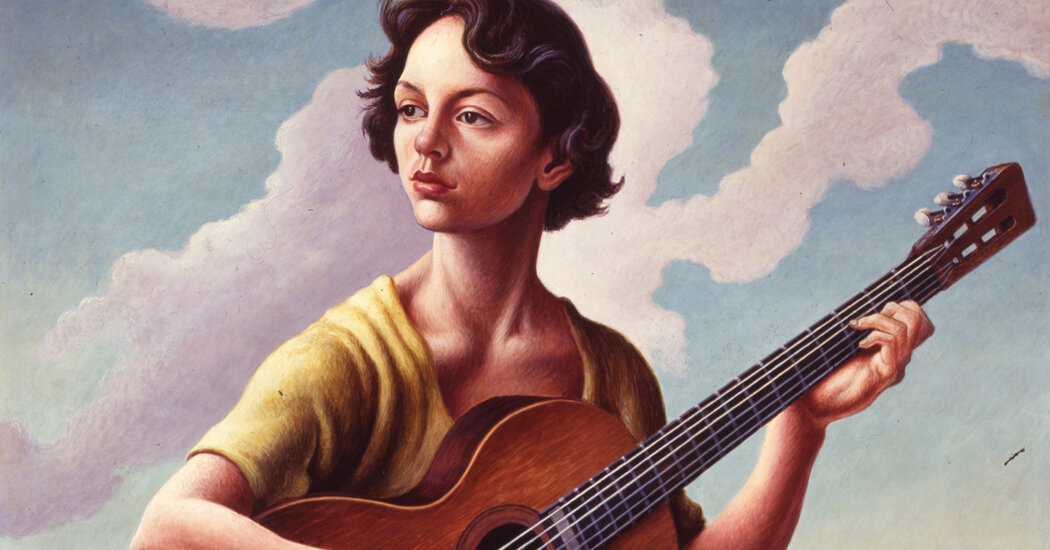
This article is part of our Museums special section about how art institutions are reaching out to new artists and attracting new audiences.
Guitarists and their music — from folk singers to rock ’n’ roll stars and protest songs — figure prominently in American history and culture, but the instrument has a notable heritage of its own.
“The guitar itself can have meaning, other than simply being beautiful or making music,” said Mark Scala, chief curator at the Frist Art Museum in Nashville, where “Storied Strings: The Guitar in American Art,” on view from May 26 to Aug. 13, will explore the guitar’s symbolism in American art, from late 18th-century parlor rooms to today’s concert halls.
On display will be more than 165 works: paintings, sculpture, photography, works on paper, illustrations, videos, music in multimedia presentations and musical instruments, including a rare cittern, a popular string instrument in the 18th and 19th centuries, and seminal guitars by Fender, Gibson and C.F. Martin & Company.
Twelve thematic sections, with names like “Cowboy Guitars,” “Iconic Women of Early Country Music” and “Hispanicization,” will weave in how artists and photographers have used the guitar as a visual motif to express the American experience and attitudes, from thorny issues like race and identity to the aesthetics of guitars themselves.
Artworks in “Leisure, Culture, and Comfort: 18th and 19th Century America,” including a painting by Charles Willson Peale from 1771, the earliest image in the exhibition, will show old-fashioned scenes of women playing for pleasure or holding guitars passively.
“The guitar was seen as a symbol of cultivation and sophistication, a sign of domestic achievement, like needlework or writing poetry,” Mr. Scala said. But throughout the show, many images of guitar-playing women counter this gender stereotype, he said, by signaling self-confidence, independence, creativity and even sexual liberation.
“Guitars are kind of equal-opportunity story facilitators,” said Leo Mazow, curator of American art at the Virginia Museum of Fine Arts, who organized “Storied Strings, where it recently closed. (The exhibition will be adapted for the Frist, mainly to reflect Tennessee culture.)
He attributes the instrument’s popularity to its portability, affordability, easy to learn repertoire and ability to host many different genres: “One of the reasons guitars appear frequently in American art is they fit neatly within the picture plane, especially on the diagonal and one’s lap.”
The section “Blues and Folk” will focus on the role of both idioms “in the formation of a voice that comes up from the people, music that has often been conflated to express identity or to encourage change,” Mr. Scala said. Works featuring figures like Lead Belly, Odetta, and Josh White appear here. Romare Bearden’s 1967 collage, “Three Folk Musicians,” a nod to Picasso’s “Three Musicians,” Dr. Mazow said, “is a powerful work because it contrasts the guitar with its Western European origins to the banjo with its West African origins, but carries little to none of the racially vexed baggage that the banjo does.”
Dr. Mazow said that one of his favorite works was Thomas Hart Benton’s “Jessie with Guitar,” of the artist’s daughter, from 1957. “Every birthday he would make a drawing or a painting of her,” he explained, “and this painting is based on sketches completed the morning of her 18th birthday.” Based on conversations with Jessie, who died in February, he said, “this guitar provided a way for the older dad to bond with his young, hip daughter, who was something of a folk sensation.”
“A Change is Coming” will highlight the guitar as a vehicle of political change, with images and videos of musicians — like Woody Guthrie, Bob Dylan and Joan Baez — who “protest the hypocrisy of America’s social and political systems,” Mr. Scala said. Dorothea Lange’s 1935 photograph “Coachella Valley” details a Mexican laborer playing a guitar at a camp in California, and Annie Leibovitz’s 1984 photo of Bruce Springsteen used to promote his “Born in the U.S.A.” tour will be on view.
“Making a Living” will look at the role of money in music, “from historic paintings of blind street buskers to the ultrarich stars of today,” Mr. Scala said. Highlights include a 1912 oil painting by Robert Henri “Blind Singers,” a 1941 photograph by Walker Evans “Blind Man with Guitar,” and more recent images of Chet Atkins and the Carter Sisters performing at the Grand Ole Opry, and Dolly Parton on her tour bus.
“Personification” will explore how the guitar is often associated with the human body, through words to describe it like “neck” and “waist” and at times, phallic connotations. A photograph of B.B. King hugging his guitar named Lucille reflects how the guitar can also be a kind of extension of, or an avatar for the human body, Mr. Scala said.
“The Visual Culture of Early Rock and Roll” will feature electric guitars from the 1950s and ‘60s, including a 1959 Les Paul, instruments played by Eric Clapton, by Keith Richards of the Rolling Stones and footage of Sister Rosetta Tharpe playing electric guitar, a musician who is credited with transforming Black church music. “Most of the guitars in this section were played by male rock ’n’ roll stars,” Mr. Scala said. “I wanted to show her influence on the early development of rock ’n’ roll, puncturing the gender-specific notion of the ‘guitar god.’”
Several design milestones have contributed to the guitar’s appeal as a visual icon. “The first American guitar manufacturer, C.F. Martin,” right after he arrived from Germany in 1833, Dr. Mazow said, “is very concerned with aesthetics. There are several parts of early Martins, like the ornate deck decorations around the sound hole, that are not structural at all.” More than a century later, a 1954 Fender Stratocaster, which will be on view, is believed to be the first custom-painted model, he said. “It takes us back to a moment when one of the premier electric guitar makers decided that aesthetics count.”
Paul Polycarpou, a guitar collector, whose rare pink Stratocaster appears in the show, said, “It’s art you can play.” Mr. Polycarpou, former editor and publisher of Nashville Arts Magazine, arrived in Nashville in the 1980s from England to play guitar on tour with Tammy Wynette. “It really is ground zero for guitar players,” he said of Nashville. “Not just in country music, but in all genres, whether it’s jazz, rockabilly, rock ’n’ roll or bluegrass.”
The Frist recently opened a companion exhibition, “Guitar Town: Picturing Performance Today,” on view through Aug. 20, featuring works by 10 local photographers who celebrate Nashville’s music scene, with images of guitar players performing in venues across the city.
“Anywhere in America, if you’ve got a story to tell, the guitar will help you tell it,” Mr. Polycarpou said. “That’s what makes it such a powerful symbol. Who can forget Elvis Presley, rocking with that guitar? You can’t forget that image of a young Bob Dylan singing ‘Blowin’ in the Wind’ on a black-and-white television. You can’t forget that once you see it. It’s that powerful.”













